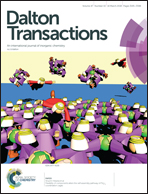A novel fluorescent probe based on biphenyl and rhodamine for multi-metal ion recognition and its application†
Abstract
At present, the design of multi ion sensing receptors is a new area of research due to their potential application in the recognition of analytes. Herein, a novel fluorescent probe for the detection of multi metal ions was designed and synthesized based on the fluorophores of biphenyl and rhodamine. Probe 1 exhibits multiple fluorescence responses to various metal ions (Zn2+, Al3+, Cr3+ and Fe3+) and is accompanied by different optical signal outputs. Moreover, the interference between the target ions can also be effectively solved by the introduction of probe 2 and the addition of the corresponding anions. Probe 1 was also successfully used to detect trace metal ions in real water samples and silicone plate test strips were prepared for the rapid qualitative detection of target metal ions. In addition, in order to better understand the multiple response mechanism of probe 1, geometry optimizations and electronic calculations were carried out at the B3LYP/6-31G*/LANL2DZ level of theory. And harmonic vibrational frequency calculations were also carried out to ensure that all optimized structures were at energy minima on the potential energy surface.



 Please wait while we load your content...
Please wait while we load your content...